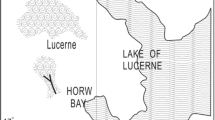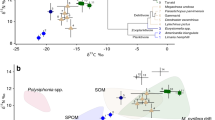Abstract
Two experiments were conducted to determine the effect of the type of sediment organic matter and geochemical conditions during diagenesis on the stable carbon isotope ratio δ13C of the deposit-feeding polychaete worms Capitella spp. Laboratory experiments showed δ13C values of-13.5 to-13.9%. for worms grown on fresh and aged kelp, Macrocystis pyrifera. Field experiments on worms in the Santa Barbara Channel, California (USA), in 1986 revealed more negative δ13C values (to-19%.) when oil and kelp were added to sediments. The more negative values suggest the incorporation of oil carbon into worm tissues, supporting previous indications of the importance of hydrocarbons in food webs near oil seeps.
Similar content being viewed by others
Literature cited
Bauer, J. E., Capone, D. G. (1985). Degradation and mineralization of the polycyclic aromatic hydrocarbons anthracene and naphthalene in intertidal sediments. Appl. envirl Microbiol. 50: 81–90
Benner, R., Fogel, M. L., Sprague, E. K., Hodson, R. E. (1987). Depletion of 13C lignin and its implications for stable carbon isotope studies. Nature, Lond. 6141: 708–710
Blair, N. E., Martens, C. S., DesMarais, D. J. (1987). Natural abundances of carbon isotopes in acetate from a coastal marine sediment. Science, N.Y. 236: 66–68
Brooks, J. M., Kennicut II, M. C., Fisher, C. R., Macko, S. A., Cole, K., Childress, J. J., Bigidaire, R. R., Vetter, R. D. (1987). Deep sea hydrocarbon seep communities: evidence for energy and nutritional carbon sources. Science, N.Y. 238: 1138–1142 (1987)
Cline, J. D. (1969). Spectrophotometric determination of hydrogen sulfide in natural waters. Limnol. Oceanogr. 14: 454–458
Davis, P. H., Spies, R. B. (1980). Infaunal benthos of a natural petroleum seep: study of community structure. Mar. Biol. 59: 31–41
DeNiro, M. J., Epstein, S. (1978). Influence of diet on the distribution of carbon isotopes in animals. Geochim. cosmochim. Acta 42: 495–506
Fry, B. (1984). 13C/12C ratios and the trophic importance of algae in Florida Syringodium filiforme seagrass meadows. Mar. Biol. 79: 11–19
Fry, B., Lutes, R., Northam, M., Parker, P. L. (1982). A 13C/12C comparison of food webs in Caribbean seagrass meadows and coral reefs. Aquat. Bot. 14: 389–398
Grassle, J. P., Grassle, J. S. (1976). Sibling species in the marine pollution indicator Capitella (Polychaeta). Science, N.Y. 192: 567–569
Haines, E. B., Montague, C. L. (1979). Food sources of estuarine invertebrates analyzed using 12C/13C ratios. Ecology 60: 48–56
Hambrick, G. A., DeLaune, R. D., Patrick, W. H. (1980). Effect of estuarine sediment pH and oxidation-reduction potential on microbial hydrocarbon degradation. Appl. envirl Microbiol. 40: 365–369
Hanson, R. B., Tenore, K. R. (1981). Microbial metabolism and incorporation by the polychaete Capitella capitata of aerobically and anaerobically decomposed detritus. Mar. Ecol. Prog. Ser. 6: 299–307
Macko, S. A., Lee, W. Y., Parker, P. L. (1982). Nitrogen and carbon stable isotope fractionation by two species of marine amphipods: laboratory and field studies. J. exp. mar. Biol. 63: 145–149
Lucas, M. I., Newell, R. C., Velimirov, B. (1981). Heterotrophic utilization of mucilage released during fragmentation of kelp (Ecklonia maxima and Laminaria pallida). 2. Differential utilization of dissolved organic components from kelp mucilage. Mar. Ecol. Prog. Ser. 4: 43–55
Martens, C. S., Blair, N. E., Green, C. D., DesMarais, D. J. (1986). Seasonal variations in the stable carbon isotope signature of biogenic methane in a coastal sediment. Science, N.Y. 233: 1300–1303
McConnaughey, T., McRoy, C. P. (1979a). Food-web structure and the fractionation of carbon isotopes in the Bering Sea. Mar. Biol. 53: 257–262
McConnaughey, T., McRoy, C. P. (1979b). 13C label identifies eel grass (Zostera marina) carbon in an Alaskan estuarine food web. Mar. Biol. 53: 263–269
Montagna, P. A., Bauer, J. E., Prieto, M. C., Hardin, D., Spies, R. B. (1986). Benthic metabolism in a natural coastal petroleum seep. Mar. Ecol. Prog. Ser. 34: 31–40
Mullin, M. M., Rau, G. H., Eppley, R. (1984). Stable nitrogen isotope ratios in zooplankton: some geographical and temporal variations in the North Pacific. Limnol. Oceangr. 29: 1267–1273
Newell, R. C., Lucas, M. I. (1981). The quantitative significance of dissolved particulate organic matter released during fragmentation of kelp in coastal waters. Kieler Meeresforsch. (Sondh.) 5: 356–369
Reed, W. E., Kaplan, I. R. (1977). The chemistry of marine petroleum seeps. J. geochem. Explor. 7: 255–293
SAS Institute, Inc (1985). SAS/GRAPH ® user's guide, statistics. Version 5 ed. SAS Institute, Inc., Cary, North Carolina
Spies, R. B., Davis, P. H. (1979). The infaunal benthos of a natural oil seep in the Santa Barbara Channel. Mar. Biol. 50: 227–237
Spies, R. B., DesMarais, D. J. (1983). Natural isotope study of trophic enrichment of benthic communities by petroleum seepage. Mar. Biol. 73: 67–71
Stephenson, R. L., Tan, F. C., Mann, K. H. (1986). Use of stable carbon isotope ratios to compare plant material and potential consumers in a seagrass bed and a kelp bed in Nova Scotia, Canada. Mar. Ecol. Prog. Ser. 30: 1–7
Tenore, K. R. (1977a). Growth of Capitella capitata cultured on various levels of detritus derived from different sources. Limnol. Oceanogr. 22: 936–941
Tenore, K. R. (1977b). Utilization of aged detritus derived from different sources by the polychaete Capitella capitata. Mar. Biol. 44: 51–55
Tenore, K. R. (1981). Organic nitrogen and caloric content of detritus. I. Utilization by the deposit-feeding polychaete, Capitella capitata. Estuar. cstl mar. Sci. 123: 39–47
Author information
Authors and Affiliations
Additional information
Communicated by P. C. Schroeder, Pullman
Rights and permissions
About this article
Cite this article
Spies, R.B., Bauer, J.E. & Hardin, D. Stable isotope study of sedimentary carbon utilization by Capitella spp.: effects of two carbon sources and geochemical conditions during their diagenesis. Mar. Biol. 101, 69–74 (1989). https://doi.org/10.1007/BF00393479
Accepted:
Issue Date:
DOI: https://doi.org/10.1007/BF00393479




